#helped over 60 slaves run for freedom! He is a tragic hero!
Explore tagged Tumblr posts
Text
Letting Go/Non-Attachment
This will be taking place in the Desert Speaker Universe. I have shown and explored alot of how Obi-wan is trapped by his past, and what has happened. I think I would like to now explore the parts of Omi that they cannot let go of. The people Omi has lost.
WARNING: GRAPHIC DESCRIPTIONS OF INJURIES. PLEASE SKIP IF THIS WILL NEGATIVELY IMPACT YOU.
Omi wakes up screaming.
Tears-a waste of water- pouring down their face. The face of Kereth as sand tore flesh from bone, trapped in their mind's eye, haunting them even awake.
Around the room, the delicate sand sculptures Omi had begun to craft with the force were floating, vibrating and cracking.
Every single beautiful thing that they had created, fracturing and promising pain.
The first sob breaks past Omi's teeth, and the sound cracks through the air. Every glass sculpture in the room shatters.
Omi, leg throbbing with pain- they can't quite tell if it is phantom or real this morning- struggles to their feet and drags themself out towards the canyon wall, weeping as quietly as they can.
'Kereth... What am I doing here? You were so much brighter than I, born to the suns and promised to them to. I was born to darkness... How could I ever think that I would escape it?'
"Omai? Padawan what is-"
Omi whirls, and snaps "YOU DON'T UNDERSTAND! I LOST HIM. I LOVED HIM. I LOst him."
Marrat Ben Kenobi's eyes widen, the gray blue sharpening.
"Padawan. I need you come here. Sit with me, we should meditate on this."
"Marrat... Marrat I can't. He was my only light for so long- I ran from my master expecting, no, hoping to die. I knew that my chip was in a spot that promised death if I didn't get help. That's why I went into the wastes. I couldn't- I still feel as though I can't make it without him. How do I continue to walk in the suns, in the light, when my light has died. When he, the one who could think positive, who looked as who he could help, who gave and gave, and never once asked for his own freedom, sacrificed his life for me?"
Ben's wrinkled faces is sad, aging before Omi's eyes. "Omai, have I taught you of the jedi code?"
Omi's anger bursts higher, the apparently unrelated topic change making them mad enough that they pushed themselves up in a single smooth motion.
"Omai, listen. This is important. Have I taught you it?"
"Unless you are referencing 'do or do not, there is no try,' no you haven't taught me that."
"Come. Sit. Let me teach the foundation of the jedi. We learn this throughout our walk with the force, growing from the simple meditation chant we are taught a crechelings."
Omai begrudgingly takes a seat out is the cold sands, two crescent moons framing a full one in the sky.
"The jedi code is a study in duality, in the abscene of absolutes. In the existence of contradictory ones. The force is not something to be quantified. But it is not un-quantifiable. Does this sound confusing yet?" Ben smiles, a mischievous twinkle in his eye
Omi, disgruntled and frustrated, just huffs.
"There is no emotion, there is peace.//There is no ignorance, there is knowledge.//There is no passion, there is serenity.//there is no chaos, there is harmony.//There is no death, there is the Force."
Omi looks up sharply, mouth opening.
"This is not the jedi claiming the ability to raise the dead. This is jedi, and how we expeariance the wonderful universe that connects everyone and everything, and where our loved ones are once they are gone. They are part of the great cosmic soup. We can't pick out every single person who has joined it, but we can reach out and feel thier impact on our lives. We can know that when we join the force, we can mingle and exist alongside them again."
"So, before you say anything to me about how the person you lost wasn't a jedi- I never said only jedi join the force. We believe that everyone, force sensitive, or force null, are connected. The Force is in everyone. So letting go isn't forgetting. It isn't betraying them. It isn't spitting on thier memory. It is entrusting your loved one to the force who has cradled and cared for you with the care of a dear one. But you must let go of the grief of your lost, or you are trapped searching for a way to bring them back, to tear them from the safety you have always relyed on. There is no death..."
Omi takes those words and breathes, fully examining them.
'There is no emotion, there is peace' But emotions are a part of existing...and peace is something we strive and wish for- peace from our gut reactions, peace in a crazy world, peace in the face of soul wrenching pain.
It's not a striving for no emotions, but a state of peace alongside them so that my heart does not rule when a cool head is more beneficial.
'There is no ignorance, there is knowledge.' Ignorance is actively choosing to not learn, to not change from the expeariances that you have. There is only the learning and knowing based off the things that occur.
I should not strive to remain the same, I should strive to continue to learn from everything I experience, and not ignore what is coming due to pain.
'There is no passion, there is serenity.' There is no passion, there is serenity. Passion is a dangerous state to be in. Crimes of passion are some of the worst that can occur.
When emotions hit a high point, I should actively step back and seek out serenity, or calmness so I can observe and respond responsibly.
'There is no chaos, there is harmony.' Chaos is a state where so much is happening, that there is too much. Everything is fractured and insane, like the state of being inside a sandstorm, There is nothing but trying to survive in chaos. Harmony is providing a balance or dichotomy to the chaos. I should strive to actively observe my environment , and move through it with the intention of providing balance.
'There is no death, there is the Force.' Death is part of life. There is nothing that encourages people to want to forever exist on the earth, for the balance of life is death so that the resources are returned to the cycle. There is only to eternally connecting concept of the Force, which is life, death, and everything in between. Dying does not separate you from the world, for death is part of life, is part of the force.
"There is the force." Omi breathes more, tears slowing. "I have not lost Kereth, I have only lost his physical presence beside me. I have the Force, and Kereth is part of the force."
"Yes, precisly, my dear padawan. So, we let them go. We entrust thier luminous forms to the force who cares for us. Can you entrust Kereth to the Force, Omi?"
"I must, Marrat. Chaining Kereth here is a far worse fate for him to entrusting him to bright light that encompasses the universe I will not be seperated from him forever- I will not be lost to death, but returned to the force."
"Very good, Omi. That is the root of non-attachment. We release the people we love to the force- alive or dead."
"And we follow the force to new people who need us."
"Precisely."
#jedi june#star wars#teeaves does star wars#Desert Speaker AU#I made myself cry a little with this#Sorry its so late- it's a bit difficult to break down the tenets of the jedi order in normal terms rather than just in my heart.#I kinda love it. I felt very connected to the force when I wrote that part!#Enjoy Omi Khepareth#Omai Sunwalker#Kereth was a mikkian slave with Omi on tatooine. Kereth took Omi's punishment when the stolen medicinal herbs were discovered#Kereth was good at connections. He was growing into a Grandfather figure for the quarters#but was not there yet.#Kereth was actually force sensitive too!#helped over 60 slaves run for freedom! He is a tragic hero!#Enjoy!#angst#tw graphic depictions of violence
3 notes
·
View notes
Text
“Hatari!” An example of queer coding in film history
As I watched for the first time in years the movie “Hatari!” a new perspective came to mind, and I discovered a secret my subconscious had been telling me about since childhood. “Hatari!” is a simple, charming kind of romantic comedy-adventure, about a group of hunters in Africa that catch animals and sell them to Zoos all over Europe. The movie is quite forgotten nowadays since it has no big thrills, action scenes, dramatic love story or gross out humor. It is only remembered as one of the decent John Wayne movies. But it turns out, it is also an example of queer coding done right and for the right reasons and contains a beautiful powerful gay “bromance” story.
So, let’s do this.

I know what a lot of you may be thinking. Queerbaiting is never right! But queer coding and queer baiting are not the same. It is only recently that the LGBT community has gained its rights, and even now the representation in media is usually not very good or inexistent, just as with the majority of minorities. But during the 40, 50 and 60 eras things were much worse. Since the beginning of Hollywood, films had to be approved by the censors before they could appear on screen. No extreme violence, no sexual relations, no communist propaganda and definitely no queer content was allowed. However, things got worse when in 1946 the Hollywood Blacklist started. It was then when screenplayers, actors, and directors started to be imprisoned for their beliefs. And until 1960, when Trumbo was actually recognized and accepted back in Hollywood the Blacklist stayed. But even afterward, the witchhunts and censorships continued. Therefore, those who wanted to tell different stories, present outside characters or represent themselves had to use coding and subtext to do so. And thus, queer coding became a loudly spoken secret, just as subtextual communist ideas or sexual tension and innuendos disguised as the fight of the sexes. And “Hatari!” a movie by the great Howard Hawks and released in 1962, made a great and positive use of this, which is why I wanted to use this movie as an example.
The film tells the story of the chief of the hunters, played by John Wayne, who falls in love with a photographer that works for a zoo from Switzerland. At first, it seems he can’t stand her, and he assumes she is going to be trouble. But as their relationship blooms and they even adopt three motherless elephants, it turns out they are quite a good match for each other. Of course, it is not this two characters that interested me in my new viewing of the movie. Although when I watched it for the first time with my father, who loves it, I thought they were the most relevant characters of the story, two other characters caught even then my attention. And it’s about their relationship I want to talk here.
The movie begins with one of the hunters getting hit by a rhinoceros. Immediately, they all rush to hospital, but by the time they arrive, “The Indian” has already lost a lot of blood. It is then when a new character appears. A French guy named Charles Maurey that has heard they’ll be needing a new worker. Of course, Kurt Muller, a German car racer that is part of the hunter’s team, jumps immediately with anger. His friend is “not yet dead”, and so he hits the French guy. However, as it turns out “The Indian” has a pretty rare blood type, and the only person that can transfuse him is the French man. But Charles does not care about the job anymore, he just wants Kurt to ask him for help. Thus their love story begins. Even if very few people will recognize this couple as more than friends, the coding is there.

Charles, who soon will be called “Chips” by his new colleagues, and Kurt are the only male characters in the entire movie that are somewhat sexualized. The female love interests appear almost always fully and usually quite modestly clothed ( the only exception being the time Dallas is “attacked” by a leopard while showering). In fact, you could say, especially if you look at other movies the actresses partook in, that they were unsexualized in this one. In contrast, “Chips” always shows off his muscles under are a tight blue shirt and a pair of “Rebel-without-a-Cause-Glasses”; and Kurt wears the shortest pants with pride, while he unbuttons his collar, and makes the same use of his glasses.
The second time they meet, some days have passed since “The Indian” got send to the hospital, and John Wayne receives a call, telling him that “Chips” abandoned the place after asking for money. Kurt assumes that he has gotten the money for himself and is not going to appear again. But soon after, the French comes by, a rifle that he bought back with the money he asked for in his hands, and ready to apply for the job. After they try him out and realize he’s a good shot, Kurt seems to be quite happy to accept him and even gives him his weapon. “Chips” punches him in the face and asks him afterward: “Do you still want me?”
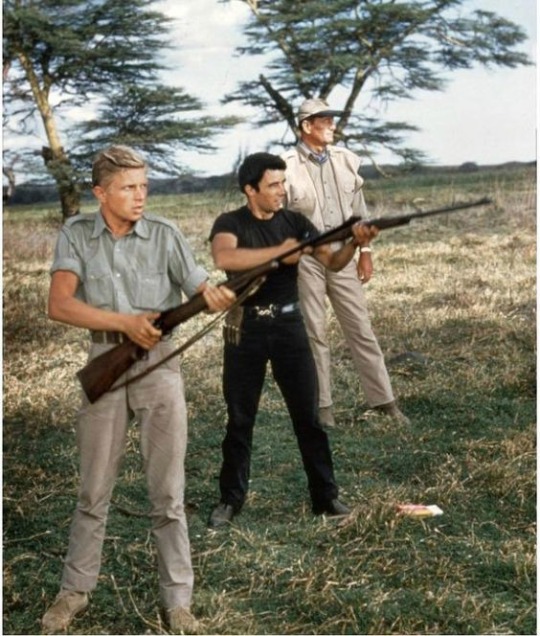
It was at this point that I first noticed the queer coding. Who would ask if someone still wanted him when he was applying for a job? Funny enough, it was obvious that the reason they did not like each other at the beginning was mare Pride from “Chip’s” side and Prejudice from Kurt’s part. But after this, they become close friends. They drive together in the same car, they wear the same glasses, are always close to each other, “Chips” even safes Kurt’s life at one point… And yes, they also fight for the same girl. You may wonder how that’s possible if they are both gay. However, it was rather usual for queer coded movies to put a female love interest in between “gay acted” characters, in order for the film to pass the censorship. It is obvious if you see the movie that neither of the two men is really interested in the girl they are chasing. They pass more screen time looking at each other than at her, and when it turns out that she is in love with the comedic character, they accept it easily and Kurt invites “Chips” for a drink.
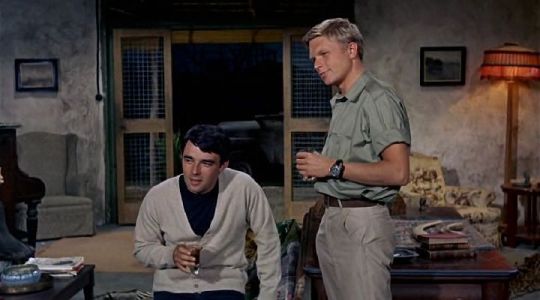
What is great about this movie is that you can easily see when the screen players or director thought, they were being too obvious, as immediately after a very close scene between them comes another one with a female counterpart, or were one is relegated to the background, looking at the other from time to time with apparent longing. They get hurt together, they heal their wounds together, literary in fact, and they are always driving together. By the end of the movie, they both have planned to go to Paris together and stay there until the next hunting season. They apparently both know a girl there. “It’s a good excuse for another fight,wright” says Kurt and then asks John Wayne what his love interest is going to do, therefore comparing “Chips” with the girl Wayne loves.
It is precisely this ending that makes me love the movie more. And for that to be understood we have to see how the queer coding at the time went. When we think about hidden queer characters in classics, usually there are some movies that pop up repeatedly: “Strangers on a train” by Alfred Hitchcock, “Spartacus” by Stanley Kubrick, “Some like it hot” by Billy Wilder… Each of this three examples shows a different kind of typical queer coded character:
“Strangers on a train” was not the only time Hitchcock queer coded main characters. He did the same with the movie “Rope” and the similarities between the men are quite obvious. As much as I love Hitchcock both for his films and his willingness to break molds and fight for acceptance, I have to agree with those that criticize him for making his villains gay. Even in “Strangers on a train”, where the hero is also queer coded, he ends up with a female lover instead of with his villainous gay counterpart. In that sense, “Spartacus”, the movie that helped break the Black List and is all about freedom of expression and the right to be oneself, has a similar problem. Tony Curtis plays a young, attractive and somewhat feminine slave that falls in love for Spartacus, who rescues and takes care of him. But as the story is a tragedy and a reflection of the times Trumbo lived in as he wrote it, everybody dies. Only Spartacus’ female lover survives and runs away with her baby.
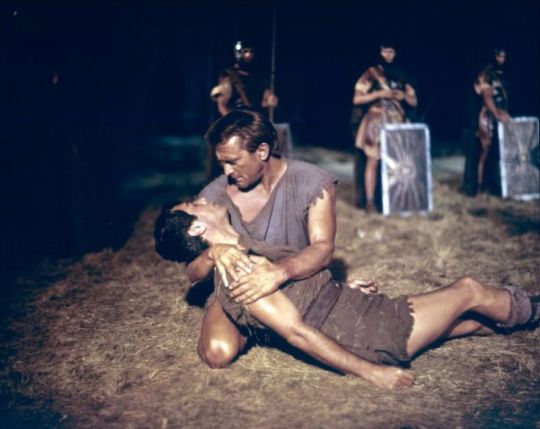
And then we have the hilarious “Some like It hot”, that is way more explicit and actually has a happy ending for the two queer coded characters. The only slight problem is that these characters are supposed to be a joke. Their sexuality is supposed to be part of the joke. By stating this, I’m not trying to devaluate these movies. They are some of the best films ever made, touching on impossible themes at the time with impeccable taste and great direction. But they also show the stereotype that would follow gay characters in movies up until now.
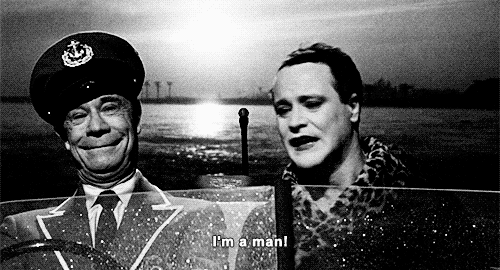
There have only been three queer characters in Hollywood for decades: The comic relief, the villain, or the hero with a tragic ending. Nothing more nothing less. And this is the brilliance of “Hatari!” in my opinion. Kurt and “Chips” are anything but gay stereotypes. They don’t have a tragic ending, they are not villains, and they are not there to be a comic relief. In fact, “Pockets” the character that so easily could have been queer coded, is the one that ends up with the girl.
This is the reason I wanted to write this essay. This two minor, overlooked characters of a movie that nobody bothers to remember could easily be the best gay couple that was written during the censorship era. And they end up happy, and they have never been outed before. So this is me pulling them out of the closet.
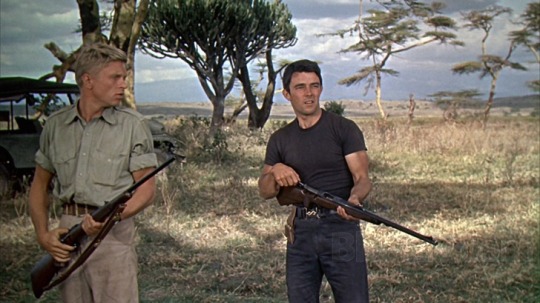
I hope you like it.
But even if you don’t believe the couple is gay, you can still enjoy the movie, as my family does, because of its light harded humour, great score from Henri Manccini, great screenplay by some of the best Hollywood writers at the time, and beautiful elephants in the room ;)
5 notes
·
View notes